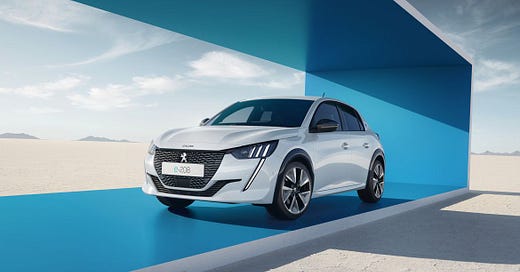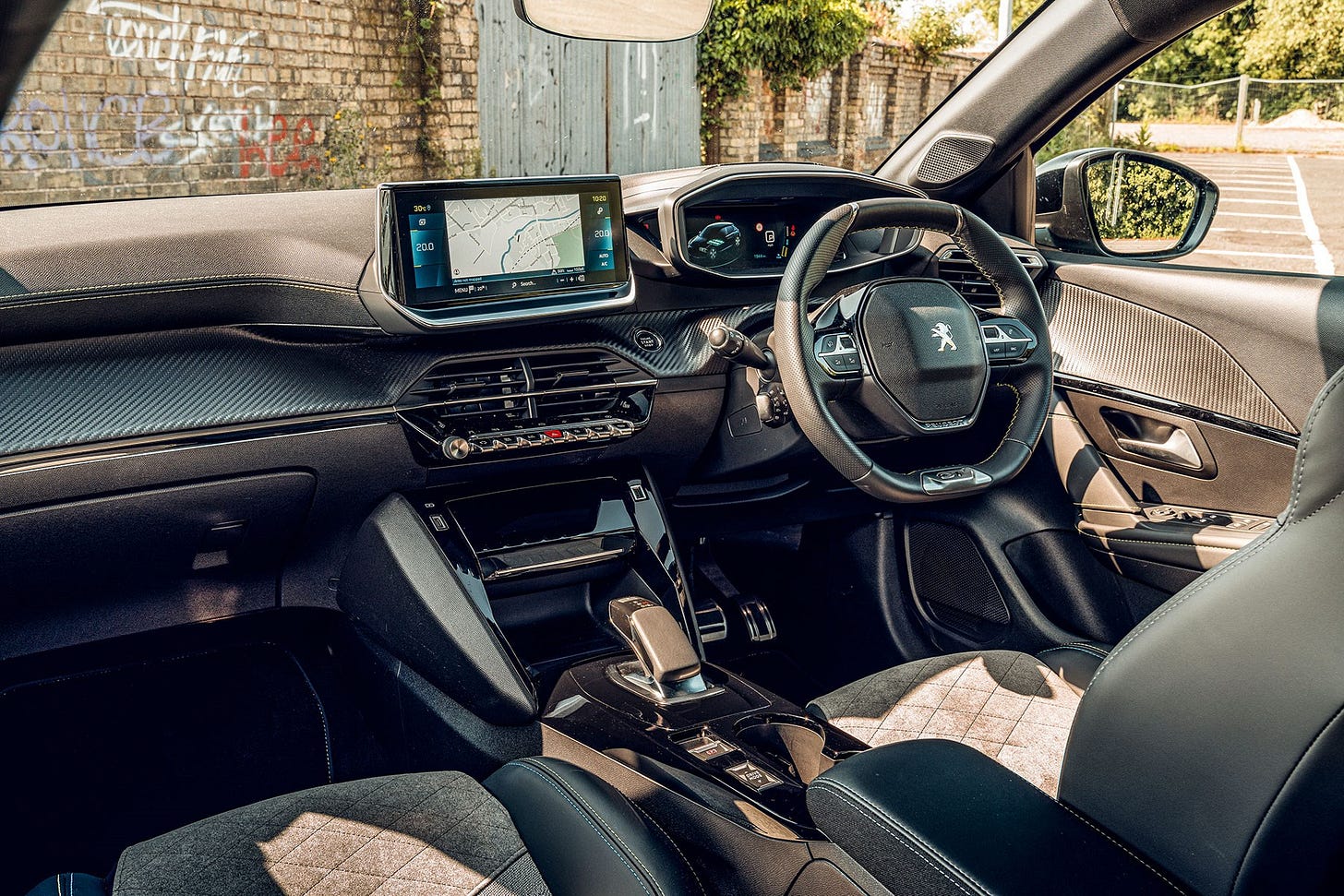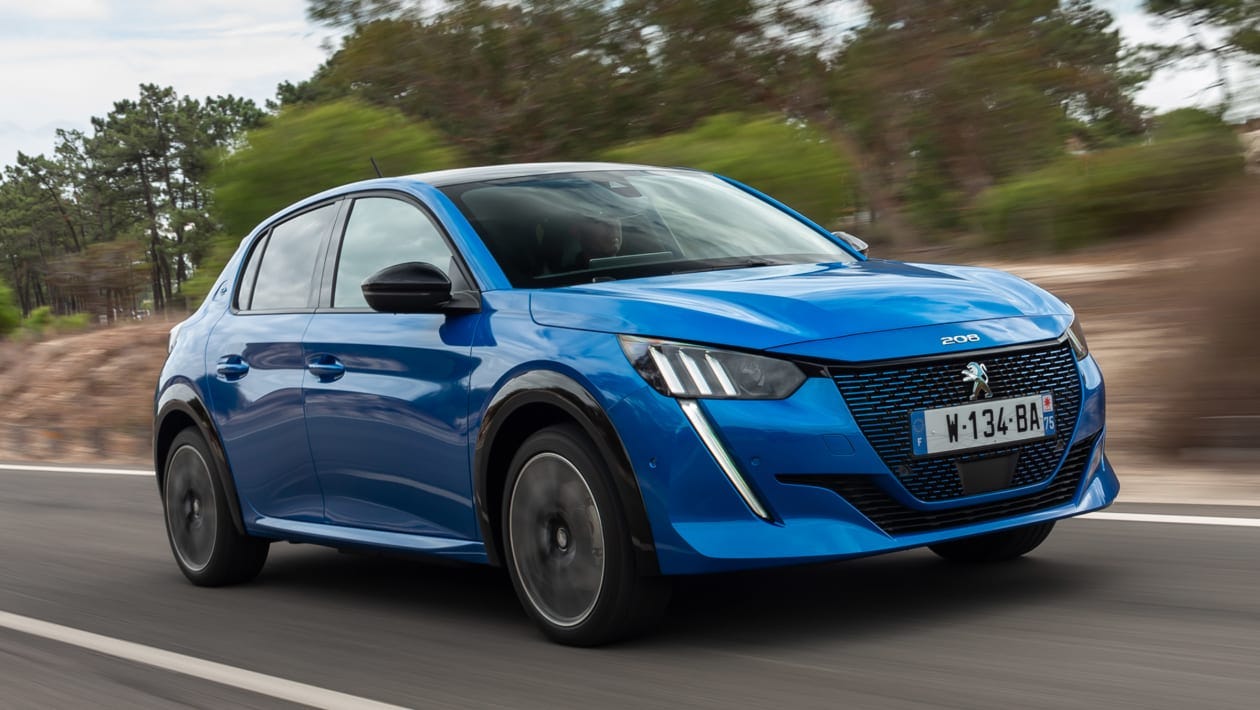The Peugeot e-208
Hello, electric car lovers! In this blog, I cover all the latest tech news surrounding electric cars. I cover the background, feel and drive, the current selling price, and the specs and engineering that go into making each car. If you have an electric car that you’d like me to cover let me know in the comments below. In today's article, I’m reviewing the new and upcoming Peugeot e-208. I’ll cover the most important features to see whether it stands against the competition. Oh, and one more thing before I start -You know what would suck about driving an electric car from Dodge?
Okkaayyyy... Now back to the article.
Background
Do you want to go electric but don't want to make a big deal about it? The Peugeot e-208 could be the right vehicle for you.
The Peugeot 208, subsequently Stellantis, is a supermini automobile (B-segment in Europe) developed by the PSA Group. In March 2012, it debuted at the Geneva Motor Show. In April 2012, the 208 superseded the 207, and the automobile is now in its second generation.
In March 2019, the second generation Peugeot 208 was introduced at the Geneva Motor Show, and it went on sale in Europe during the summer.
At Geneva, the e-208, a completely electric variant, was also unveiled. The 208 is available with a variety of powertrains, including traditional petrol and diesel engines, as well as an electric motor.
Unlike rival modern vehicles such as the Renault Zoe and Volkswagen ID.3, the e-208 shares a chassis with the traditional petrol/diesel 208. Peugeot did it on purpose to allow potential consumers to choose the drivetrain that best meets their needs.
This also enabled Peugeot to build the e-208 on the same assembly line as the 208 in Trnava. The e-208 is around 350 kg (770 lb) heavier than conventionally powered variants of the 208, and has a slightly larger rear axle to accommodate the battery pack.
So, unlike many of its competitors, such as the BMW i3, Honda E, and Renault Zoe, this isn't a customized electric car meant to stand out from 'regular' petrol and diesel automobiles - it's simply a Peugeot 208 with a large battery and an electric motor instead of a cylinder and piston engine. The unobtrusive 'e' badging on the rear haunches of the car is the only major visual distinction between the petrol and diesel versions of the 208. You'll also notice a few electric-specific elements on the driver display when you get behind the wheel. The e-208 is available in the same trim levels as the standard 208, including Active, Active Premium, Allure, Allure Premium, GT, and GT Premium.
The Peugeot e-208, as the French brand's first mass-produced electric vehicle (EV), is a significant and well-timed move. The e-208, on the other hand, must have a long real-world range in order to compete with rivals like the Fiat 500, Zoe, Mini Electric, and Vauxhall Corsa-e in other areas.
Stick with me for the next few minutes as I compare the Peugeot e-208 to its main electric competitors in my in-depth evaluation.
Design and Engineering
For those considering making the move to an electric vehicle, the Peugeot e-208 might be an excellent starting point. It has a stylish appearance and is more practical on a daily basis than competitors such as the Honda e and Mini Electric.
Interestingly enough, it's also quite similar to the Vauxhall Corsa-e — both brands are owned by the same parent company and are virtually identical.
The very first automobiles were electric vehicles, but comparing them to current electric vehicles like the Peugeot e-208 is like comparing the most recent iPhone with morse code in terms of sophistication. Because of its sculpted bonnet, three-claw LED light patterns, and visible piano black trim at the back, the e-208 has a striking appearance.
Aside from the 'e' badge and a distinctive Peugeot emblem that changes color depending on the light, you can tell it apart from the ordinary 208. In terms of size, the electric 208 has an overall length of 4.05 m for a width on the wheels of 1.77 m and a height of 1.43 m.
Interior
I'll start with a contentious topic: the driving position of the e-208. I'm told you're intended to look above, rather than through, the steering wheel to see the iCockpit digital instruments (speedo, rev counter, etc.) - something Peugeot has attempted to make simpler by downsizing the steering wheel to the size of a dinner plate.
And if you're tall or like to sit close to the steering wheel with your seat jacked up, you'll probably think the whole thing is fantastic. However, many people will discover that the steering wheel totally hides their view of the gauges, forcing them to move the wheel or seat to an uncomfortable position merely to see how fast they're going. As a result, I strongly suggest having a test drive before purchasing. Because of its normal-sized steering wheel and better digital gauges, the Corsa-e, which is closely comparable, does not have this issue.
The '3D' look of the instruments (standard from Allure Premium trim onwards) is likewise an example of style over substance; it is stated to make the gauges more difficult to see at a glance than rivals like the Renault Zoe or Mini Electric. At the very least, the speed readout is prominently shown. Depending on your demands, you can also prioritize sat nav maps or other information.
According to reviews, the quality of the inside is superb. The dashboard materials are pleasantly squishy, the steering wheel leather has a fine texture, and there are less harsh and scratchy plastics than in a Zoe or Corsa-e, however the Mini Electric seems even classier on the interior.
A 7.0-inch touchscreen is standard, with a larger 10.0-inch touchscreen available as an option on Allure Premium and standard on GT and GT Premium variants. In any case, the visuals aren't terrific, and the screen is reported that it doesn't always respond to prods as quickly as you'd want, but Apple CarPlay and Android Auto smartphone mirroring are standard. It's frustrating, though, that you have to use the touchscreen to control the air conditioning; it would be a lot better if there were real dials for regulating the interior temperature, like there are in the Corsa-e. Overall, the 500, Zoe, and Mini have better infotainment systems (particularly with the updated 8.8in screen).
Despite the fact that the e-208 is a little car, even tall people should have adequate room in the front. There's enough head and leg room, and the cabin is spacious enough to avoid an elbow conflict between front-seat passengers.
There's also plenty of storage in the form of large door bins, numerous compartments, and a tray at the bottom of the dashboard. Above that, a concealed compartment snaps up to provide more storage space – it's also where you'll discover the wireless phone charging pad if you choose that option.
Leg room in the rear is adequate, and there is plenty of room for passengers' feet under the front seats. While headroom is limited, it is superior to that found in the Fiat 500, Mini Electric, and Renault Zoe. Just make sure you don't add a panoramic sunroof because it would drop the ceiling height significantly.
The back door openings on both the e-208 and the Corsa-e are quite tiny, making it difficult to climb aboard, according to some reviewers. However, there are rear doors, whereas the competitor Fiat 500 Mini Electric is only available in three-door configuration.
If you're asking if there's a difference between an e-208 and a petrol or diesel version in terms of baggage space, the answer is no. Every 208, whether it's gas or electric, has the same boot capacity. That means you can carry more stuff than in a Mini Electric, while a Zoe can carry even more. Unfortunately, unlike the Mini, there is no convenient height-adjustable boot floor.
Performance
Let's begin with the figures. The e-208 has a 45kWh battery that drives a 100KW electric engine, which propels the car from 0-60mph in 7.5 seconds in our tests. That means it's faster than a Renault Zoe, but not quite as quick as a Kia e-Niro or a Mini Electric.
However, ride comfort is said to be superior to that of the Zoe – or the Mini Electric for that matter. Potholes and expansion joints are the two things the e-208's soft suspension can't handle; these impediments may send jolts through the automobile. It's also reported that there's greater nosedive under braking than many competitors, including the Fiat 500 and Zoe.
The e-208, on the other hand, is quieter than its primary competitors, notably the Mini and 500, but also the Zoe. This is especially supposed to be noticeable at highway speeds, when the e-208 does an excellent job of keeping road and wind noise where it belongs: outside the car.
According to car-journalists, the e-208 isn't very enjoyable to drive, and it has more body lean than a Mini or Zoe, but it is more stable in fast bends than the smaller 500 and Honda E, and it has enough traction. Similarly, the steering is precise, and there's enough weight build-up as you enter corners to give you confidence, but don't anticipate much input.
Battery Life
Furthermore, the official range of the e-208 is outstanding, reaching up to 217 miles on a single charge. Real-world driving will not take you that far, but based on some tests, 150 miles in the winter and 170 miles in the summer are reasonable expectations without exerting too much effort. That's more distance than a Fiat 500 or a Honda E can travel, yet the Zoe has an even greater range than those vehicles.
On the issue of brakes, the e-208, like other electric vehicles, is equipped with a feature known as regenerative braking. This simply implies that energy is recovered throughout the process of slowing down and is re-injected back into the battery system. Pressing the brake pedal accentuates this effect, but it also causes the brake pedal to feel reportedly: "strangely spongy", making it difficult to slow your movement in a steady fashion.
The e-208's battery, in contrast to the Renault Zoe and Mini Electric, which are limited to charging rates of 50kW, can sustain charging rates of up to 100kW. Unfortunately, 100kW charging outlets are difficult to come by in some places in the world at the moment, but if you do manage to locate one, the e-208's battery can be recharged from 10 to 80 percent in just 30 minutes. A charge from zero to one hundred percent will take 7 hours and 30 minutes using a 7kW home charger.
Price and Model Range
Expected at the beginning of March at the Geneva Motor Show, the electric Peugeot 208 has been on the market since October 2019.
On the price side, count an initial price of $34,700 excluding bonuses for the entry-level version, the Peugeot e-208 Active. For the most upscale, the e-208 GT, the price climbs to $40,550, still excluding the ecological bonus.
Do not forget, two finishes are intended for professionals. Thus, the electric city car can be duplicated in the Active and Allure Business versions, from $35,300.
Here’s the price estimation of each trim:
e-208 Active trim costs around $34,700
e-208 Allure trim costs around $35,900
e-208 GT Line trim costs around $38,000
e-208 GT trim costs around $40,550
This wraps up my review of The Peugeot e-208, let me know what you think of it. Thank you for sticking it out through to the very end of this article! Nothing helps out my blog more than y’all reading the entire article. These articles take a long time to make and are a labor of love. If you would like to see my blog grow, please help spread the word and until next time, remember, the best experiences aren’t about where you end up, but who you’re lucky enough to be on the journey with.






